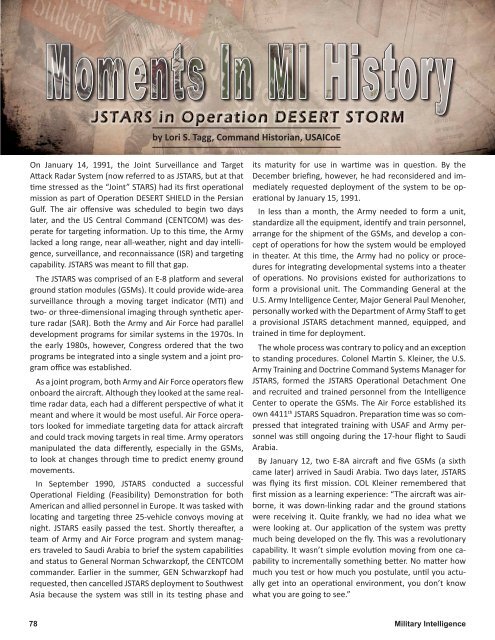incorrect
2015_02
2015_02
- No tags were found...
You also want an ePaper? Increase the reach of your titles
YUMPU automatically turns print PDFs into web optimized ePapers that Google loves.
y Lori S. Tagg, Command Historian, USAICoE<br />
On January 14, 1991, the Joint Surveillance and Target<br />
Attack Radar System (now referred to as JSTARS, but at that<br />
time stressed as the “Joint” STARS) had its first operational<br />
mission as part of Operation DESERT SHIELD in the Persian<br />
Gulf. The air offensive was scheduled to begin two days<br />
later, and the US Central Command (CENTCOM) was desperate<br />
for targeting information. Up to this time, the Army<br />
lacked a long range, near all-weather, night and day intelligence,<br />
surveillance, and reconnaissance (ISR) and targeting<br />
capability. JSTARS was meant to fill that gap.<br />
The JSTARS was comprised of an E-8 platform and several<br />
ground station modules (GSMs). It could provide wide-area<br />
surveillance through a moving target indicator (MTI) and<br />
two- or three-dimensional imaging through synthetic aperture<br />
radar (SAR). Both the Army and Air Force had parallel<br />
development programs for similar systems in the 1970s. In<br />
the early 1980s, however, Congress ordered that the two<br />
programs be integrated into a single system and a joint program<br />
office was established.<br />
As a joint program, both Army and Air Force operators flew<br />
onboard the aircraft. Although they looked at the same realtime<br />
radar data, each had a different perspective of what it<br />
meant and where it would be most useful. Air Force operators<br />
looked for immediate targeting data for attack aircraft<br />
and could track moving targets in real time. Army operators<br />
manipulated the data differently, especially in the GSMs,<br />
to look at changes through time to predict enemy ground<br />
movements.<br />
In September 1990, JSTARS conducted a successful<br />
Operational Fielding (Feasibility) Demonstration for both<br />
American and allied personnel in Europe. It was tasked with<br />
locating and targeting three 25-vehicle convoys moving at<br />
night. JSTARS easily passed the test. Shortly thereafter, a<br />
team of Army and Air Force program and system managers<br />
traveled to Saudi Arabia to brief the system capabilities<br />
and status to General Norman Schwarzkopf, the CENTCOM<br />
commander. Earlier in the summer, GEN Schwarzkopf had<br />
requested, then cancelled JSTARS deployment to Southwest<br />
Asia because the system was still in its testing phase and<br />
its maturity for use in wartime was in question. By the<br />
December briefing, however, he had reconsidered and immediately<br />
requested deployment of the system to be operational<br />
by January 15, 1991.<br />
In less than a month, the Army needed to form a unit,<br />
standardize all the equipment, identify and train personnel,<br />
arrange for the shipment of the GSMs, and develop a concept<br />
of operations for how the system would be employed<br />
in theater. At this time, the Army had no policy or procedures<br />
for integrating developmental systems into a theater<br />
of operations. No provisions existed for authorizations to<br />
form a provisional unit. The Commanding General at the<br />
U.S. Army Intelligence Center, Major General Paul Menoher,<br />
personally worked with the Department of Army Staff to get<br />
a provisional JSTARS detachment manned, equipped, and<br />
trained in time for deployment.<br />
The whole process was contrary to policy and an exception<br />
to standing procedures. Colonel Martin S. Kleiner, the U.S.<br />
Army Training and Doctrine Command Systems Manager for<br />
JSTARS, formed the JSTARS Operational Detachment One<br />
and recruited and trained personnel from the Intelligence<br />
Center to operate the GSMs. The Air Force established its<br />
own 4411 th JSTARS Squadron. Preparation time was so compressed<br />
that integrated training with USAF and Army personnel<br />
was still ongoing during the 17-hour flight to Saudi<br />
Arabia.<br />
By January 12, two E-8A aircraft and five GSMs (a sixth<br />
came later) arrived in Saudi Arabia. Two days later, JSTARS<br />
was flying its first mission. COL Kleiner remembered that<br />
first mission as a learning experience: “The aircraft was airborne,<br />
it was down-linking radar and the ground stations<br />
were receiving it. Quite frankly, we had no idea what we<br />
were looking at. Our application of the system was pretty<br />
much being developed on the fly. This was a revolutionary<br />
capability. It wasn’t simple evolution moving from one capability<br />
to incrementally something better. No matter how<br />
much you test or how much you postulate, until you actually<br />
get into an operational environment, you don’t know<br />
what you are going to see.”<br />
78 Military Intelligence


